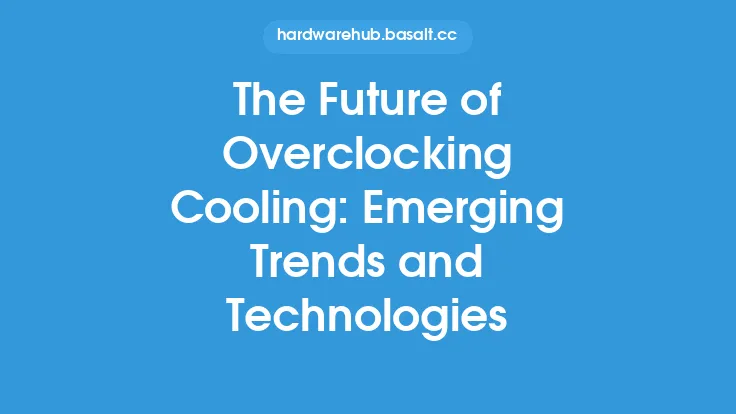The use of liquid cooling systems has become increasingly popular in recent years, particularly in the realm of high-performance computing and gaming. As technology continues to advance, the demand for more efficient and effective cooling solutions has led to the development of new and innovative liquid cooling technologies. In this article, we will explore the emerging trends and technologies in the field of liquid cooling, and what the future holds for this rapidly evolving industry.
Emerging Trends in Liquid Cooling
One of the most significant trends in liquid cooling is the shift towards more compact and modular designs. As systems become smaller and more powerful, the need for compact cooling solutions has become increasingly important. This has led to the development of smaller, more efficient pumps, radiators, and heat exchangers, which can be easily integrated into smaller systems. Additionally, the use of modular designs allows for greater flexibility and customization, making it easier for users to upgrade or modify their cooling systems as needed.
Another trend in liquid cooling is the increasing use of advanced materials and technologies, such as nanofluids, graphene, and phase change materials. These materials have been shown to have improved thermal conductivity and heat transfer properties, making them ideal for use in liquid cooling systems. For example, nanofluids have been shown to have improved thermal conductivity and heat transfer properties, making them ideal for use in liquid cooling systems. Graphene, on the other hand, has been shown to have exceptional thermal conductivity, making it an ideal material for use in heat exchangers and radiators.
Advances in Pump Technology
Pumps are a critical component of any liquid cooling system, and advances in pump technology have been significant in recent years. One of the most significant advances has been the development of more efficient and reliable pump designs, such as the use of ceramic or graphite bearings, which can improve pump lifespan and reduce noise levels. Additionally, the use of advanced materials, such as titanium or stainless steel, has improved pump durability and resistance to corrosion.
Another area of research has been the development of more efficient and compact pump designs, such as the use of miniaturized pumps or pumpless systems. These designs have the potential to significantly reduce the size and weight of liquid cooling systems, making them more suitable for use in smaller systems or applications where space is limited.
Next-Generation Radiators and Heat Exchangers
Radiators and heat exchangers are also critical components of any liquid cooling system, and advances in these areas have been significant in recent years. One of the most significant advances has been the development of more efficient and compact radiator designs, such as the use of microchannel or minichannel radiators. These designs have been shown to have improved heat transfer properties and can be more compact and lightweight than traditional radiators.
Another area of research has been the development of more advanced heat exchanger materials, such as the use of graphene or nanomaterials. These materials have been shown to have exceptional thermal conductivity and heat transfer properties, making them ideal for use in heat exchangers and radiators. Additionally, the use of advanced manufacturing techniques, such as 3D printing, has enabled the creation of complex and customized heat exchanger designs, which can be optimized for specific applications or use cases.
The Role of Artificial Intelligence and Machine Learning
Artificial intelligence (AI) and machine learning (ML) are also playing an increasingly important role in the development of liquid cooling systems. By using AI and ML algorithms, it is possible to optimize the performance of liquid cooling systems in real-time, taking into account factors such as temperature, flow rate, and pressure. This can help to improve the efficiency and effectiveness of the cooling system, while also reducing energy consumption and noise levels.
Additionally, AI and ML can be used to predict and prevent potential issues with the cooling system, such as leaks or blockages. By analyzing data from sensors and other sources, it is possible to identify potential problems before they occur, and take proactive steps to prevent them. This can help to improve the reliability and uptime of the cooling system, while also reducing maintenance and repair costs.
The Future of Liquid Cooling
As technology continues to advance, it is likely that we will see even more innovative and effective liquid cooling solutions in the future. One area of research that holds significant promise is the development of more advanced and sustainable coolants, such as the use of bio-based or plant-based coolants. These coolants have the potential to be more environmentally friendly and sustainable than traditional coolants, while also offering improved thermal performance and stability.
Another area of research is the development of more integrated and holistic cooling solutions, which take into account the entire system and its components, rather than just the cooling system itself. This can help to improve the overall efficiency and effectiveness of the system, while also reducing energy consumption and waste heat. By using advanced materials, technologies, and design techniques, it is possible to create more efficient, effective, and sustainable cooling solutions that meet the needs of a wide range of applications and use cases.
Conclusion
In conclusion, the future of liquid cooling is exciting and rapidly evolving, with new and innovative technologies and trends emerging all the time. From advances in pump technology and radiator design, to the use of AI and ML, and the development of more sustainable and environmentally friendly coolants, there are many opportunities for innovation and improvement in the field of liquid cooling. As technology continues to advance, it is likely that we will see even more effective and efficient cooling solutions in the future, which will help to meet the needs of a wide range of applications and use cases, from high-performance computing and gaming, to data centers and industrial processes.





